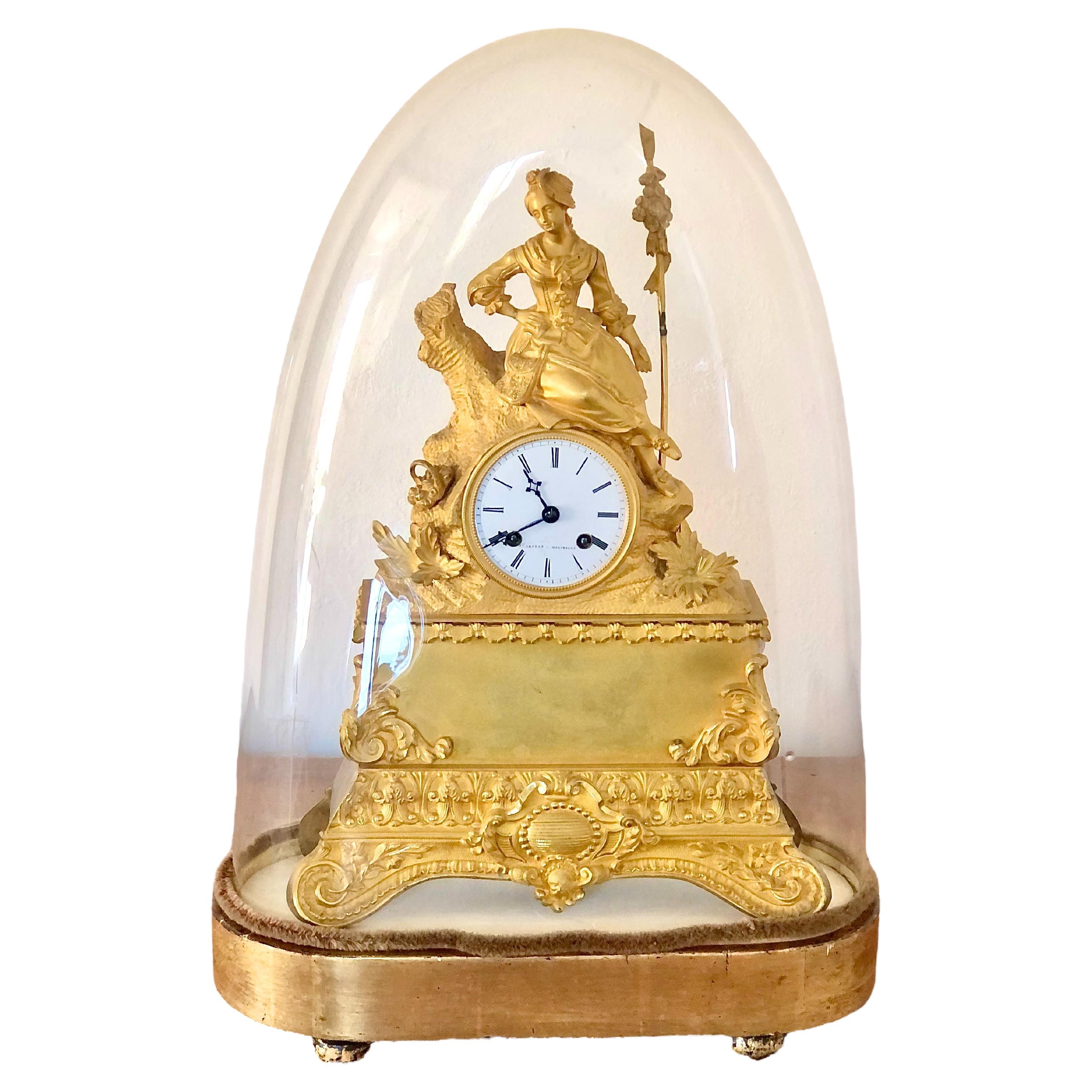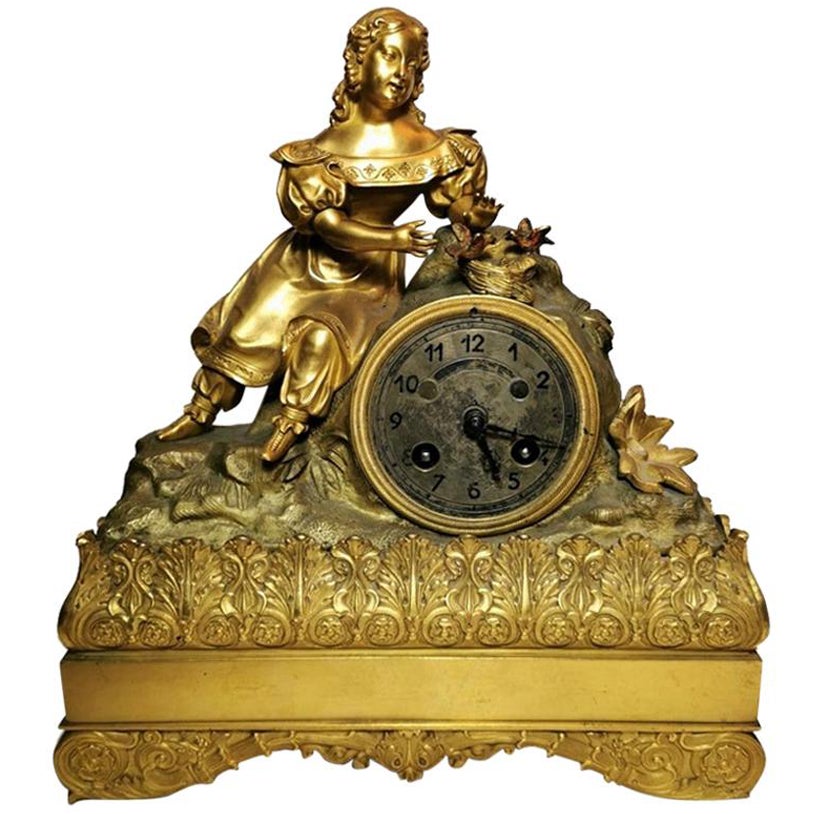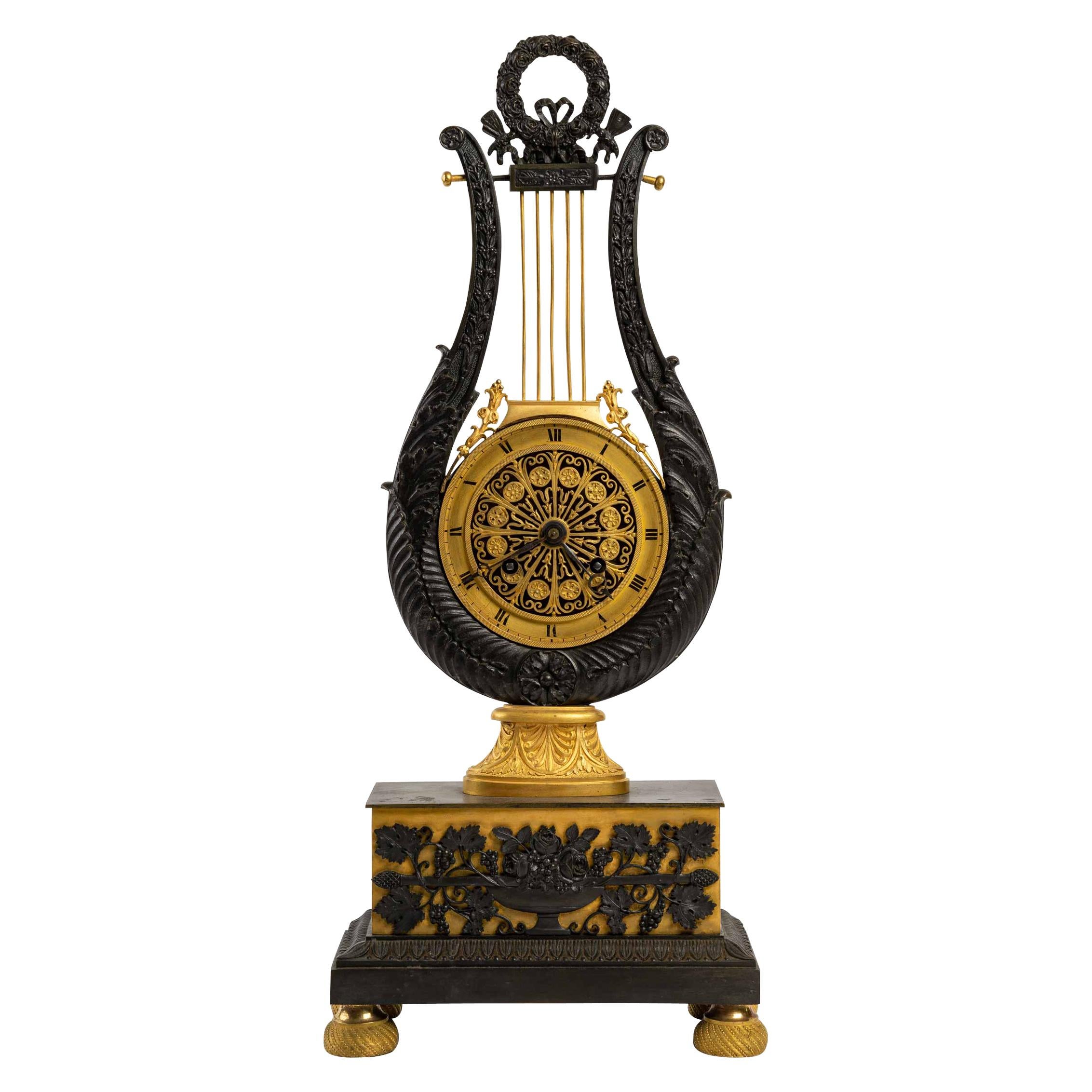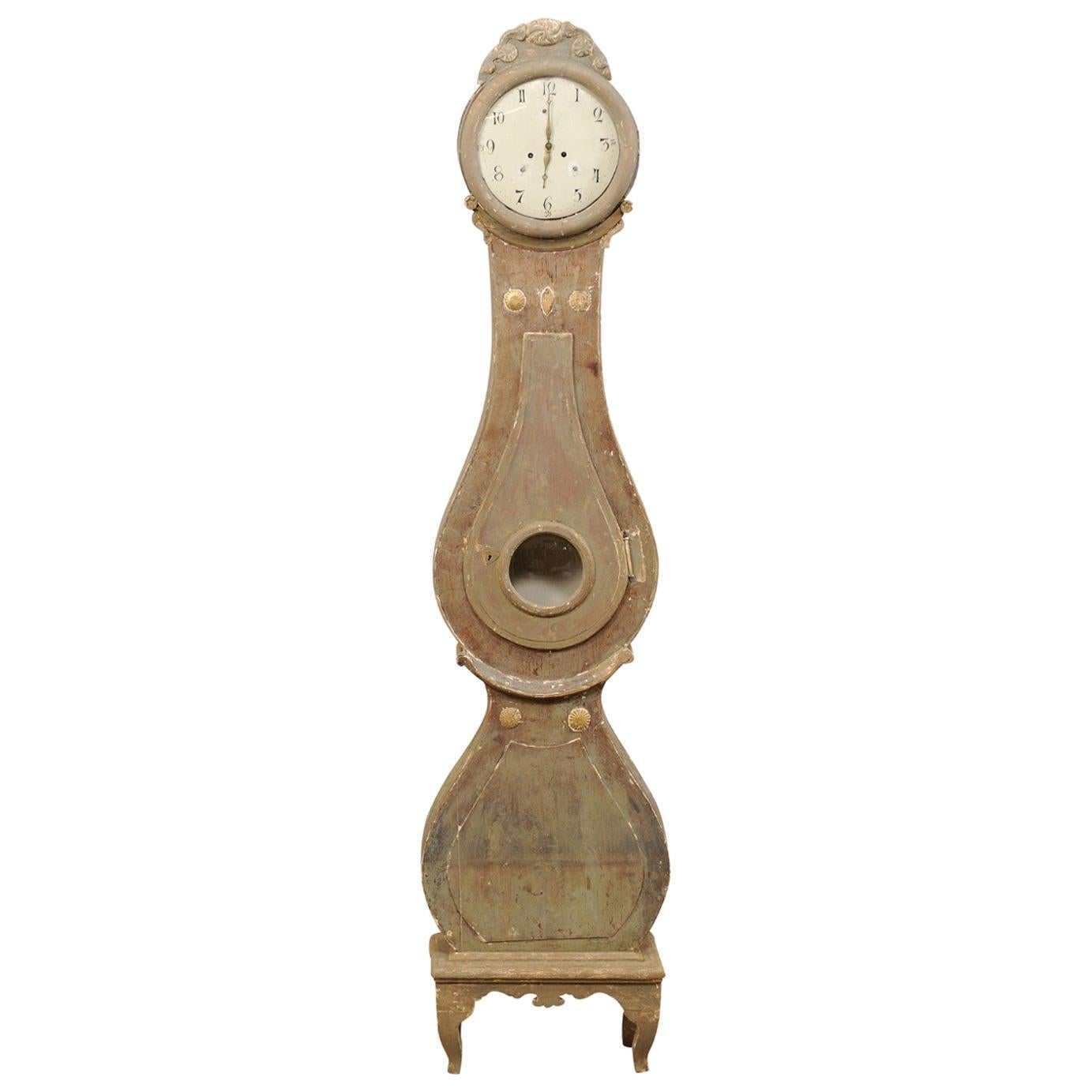Items Similar to French Fireplace Clock Made In Gilded Bronze From 1820s
Want more images or videos?
Request additional images or videos from the seller
1 of 6
French Fireplace Clock Made In Gilded Bronze From 1820s
About the Item
The French fireplace clock from the 1820s exudes timeless elegance and sophistication. Crafted from luxurious gilded bronze, this exquisite timepiece showcases the opulence and refined craftsmanship of the era.
Adorned with intricate detailing and ornate motifs, the clock's design reflects the lavish style of the early 19th century. From delicate floral patterns to elaborate scrollwork, every aspect of the clock is meticulously crafted, creating a stunning visual centerpiece for any interior space.
Standing proudly atop a mantelpiece or console table, this fireplace clock commands attention with its regal presence and timeless beauty. Its gilded finish adds a touch of warmth and richness to any room, while its intricate design captivates the eye and sparks conversation.
- Dimensions:Height: 13.39 in (34 cm)Width: 10.24 in (26 cm)Depth: 3.55 in (9 cm)
- Style:Art Deco (Of the Period)
- Materials and Techniques:
- Place of Origin:
- Period:
- Date of Manufacture:1820
- Condition:Wear consistent with age and use.
- Seller Location:Lejre, DK
- Reference Number:1stDibs: LU1209221098312
About the Seller
4.8
Gold Seller
These expertly vetted sellers are highly rated and consistently exceed customer expectations.
Established in 1986
1stDibs seller since 2015
404 sales on 1stDibs
Typical response time: 9 hours
- ShippingRetrieving quote...Ships From: Lejre, Denmark
- Return PolicyA return for this item may be initiated within 7 days of delivery.
More From This SellerView All
- French Fireplace Clock of Marble, Bronze & Decorated With Ornaments From 1840sLocated in Lejre, DKThe French fireplace clock from the 1840s is a stunning testament to the craftsmanship and elegance of the era. Crafted from luxurious marble and adorned with intricate bronze decora...Category
Antique 1840s French Art Deco Mantel Clocks
MaterialsMarble, Bronze
- Empire Style Secretary Made In Mahogany & Intarsia From 1820sLocated in Lejre, DKThis impressive Empire style secretary from the year 1820 is a true masterpiece of craftsmanship and aesthetic beauty. Hand-polished mahogany wood gives the secretary an elegant and ...Category
Antique 1820s Danish Empire Secretaires
MaterialsMahogany
- Antique Gustavian Painted Longcase Clock from Denmark, Circa 1780sLocated in Lejre, DKStep into the rich history of Danish craftsmanship with this extraordinary Antique Gustavian longcase clock, a true testament to the elegance of the late 18th century. Originating fr...Category
Antique Late 18th Century Danish Louis XVI Grandfather Clocks and Longca...
MaterialsWood, Paint
- Large Round Tin Dish from the 1820sLocated in Lejre, DKLarge round tin dish from the 1820s and in great vintage condition.Category
Antique 1820s Danish Other Decorative Bowls
MaterialsTin
- Mahogany chatol from around the year 1820sLocated in Lejre, DKMahogany chatol with four drawers and internal marquetry from around the year 1820. Dimensions in cm: H:140 W:110 D:56Category
Antique 1820s Danish Commodes and Chests of Drawers
MaterialsMahogany
- Grey Painted Hanging Glass Cabinet In Gustavian Style From 1820sLocated in Lejre, DKThe grey painted hanging glass cabinet in Gustavian style, dating back to circa 1820, exudes the elegance and sophistication characteristic of th...Category
Antique 1820s Danish Gustavian Vitrines
MaterialsWood
You May Also Like
- France, circa 1810 -1820 Table Clock with a Handmaid Mercury Gilded BronzeLocated in Milan, ITFrance, circa 1810 -1820 Table clock with a handmaid Mercury gilded bronze, alt. cm 59.5 x 40.5 x 13 Signed in the quadrant "Sezille Palais Royal Nº 133 à Paris" Akin to the prevailing taste of the Napoleonic era that envisaged a return to antiquity, the Empire Style was used for the decoration of furniture, architectural structures, furnishings, wall hangings and fabrics. The style envisaged a classical return to order, embellished by the antiquarian whimsy inspired by the recent archaeological discoveries at Herculaneum and Pompeii: the constant Roman and Hellenistic remembrance was celebrated through applications depicting laurel or oak garlands, imperial symbolism, mythological figures, sphinxes, muses, personifications and more. This watch organises the mechanical case on a parallelepiped supporting structure, subdivided into two parts connected by a sinuous greek decoration with flowers; the whole structure rests on the plane by means of convex feet decorated with a dense network of small flowers inscribed within a modular rhombus, culminating, in the attachment to the central body of the watch, with a theory of palmettes. The upper part of the parallelepiped body, inscribed with mythological figuration like the ancient stelae, encloses the latter with a frame of stylised palm leaves interspersed with discs of flowers, in turn accompanied, on the two vertical sides, by a lively vegetal triumph. Considering the iconographic range used by the bronzeworkers for the decoration of the clocks, it is possible to recognise in the mythological scene depicted the muse of poetry and music, Calliope, accompanied by the attributes of the lyre and the laurel branch, used to pay homage to poets. The two winged geniuses in front of her carry scrolls and plates on which to engrave the verses the muse dictates daily to men; the reward for human intellect is emphasised by the two similar crowns the muse holds in her hands, depicting a serpent biting its tail. This symbol, which the mediaeval era would borrow from the Hellenistic-Roman environment of Gnosticism by creating the figure of the uroboros, metaphorically manifests the purpose of the clock, being used to personify the eternal return of time and the cyclical nature of the material life of men. The case of the watch is enclosed in a zither, which is flanked by a woman crowned with laurel; the upper part has two griffin heads in correspondence with the arms of the zither, and a second female face crowned with a ring of petals/rays, again alluding to the sublime elevation of poetry. On the right side of the instrument rests a lighted torch accompanied by an extinguished upside-down torch, an allusion to present well-being, victorious over the failings of life, to which the bust of a philosopher in a disc also alludes. The dial has a porcelain ring while the hands are Breuguet. Mechanism with "anchor" escapement with silk-wire pendulum and chime...Category
Antique 1810s French Table Clocks and Desk Clocks
MaterialsBronze
- Louis XVI Style French Mantel Clock in Gilded BronzeLocated in Prato, TuscanyWe kindly suggest you read the whole description, because with it we try to give you detailed technical and historical information to guarantee the authenticity of our objects. Sump...Category
Antique Early 19th Century French Louis XVI Mantel Clocks
MaterialsBronze
- Clock in Gilded and Patinated BronzeLocated in Saint-Ouen, FRClock in gilded and patinated bronze from the Charles X period, 19th century. Measures: H 43 cm, W 19 cm, D 10 cm.Category
Antique 19th Century European Charles X Table Clocks and Desk Clocks
MaterialsBronze
- Swedish Fryksdahl Grandfather Clock with Raised Base, circa 1820sLocated in Atlanta, GAA Swedish Fryksdahl grandfather clock, raised on feet, from the 19th century. This antique Fryksdahl clock from Sweden features a beautifully raised and carved crest, the neck and un...Category
Antique 19th Century Swedish Grandfather Clocks and Longcase Clocks
MaterialsGlass, Wood
- French Antique Gilded Chiseled Bronze ClockLocated in LA CIOTAT, FRA superb quality 19th century French bronze gilt mantel clock, retaining its original glass dome, and adorned with a finely detailed rustic female figure in period dress, reclining o...Category
Antique 19th Century French Mantel Clocks
MaterialsBronze
- Empire Fire Gilded Mantel Clock, circa 1820Located in Boven Leeuwen, NLBeautiful fire gilded Empire mantel clock with a shepherdess on top with a wreath and ribbon. On the left a staff with pan flute. At the bottom of the clo...Category
Antique Early 19th Century French Empire Mantel Clocks
MaterialsBronze
Recently Viewed
View AllMore Ways To Browse
Gold Gilded Bronze
Antique Regal
French Gold Clocks
Antique Clock Designs
Antique Scrollwork
Gilded Clock
Clocks Made In France
Gilded French Clock
French Gilded Antique Clocks
Antique Floral Clock
Floral Clocks
French Gilded Mantel Clock
Gilded Bronze Clocks
Standing Antique Clock
Bronze French Table Clock
Stunning Antique Clock
Antique Timepiece
Antique Timepieces





